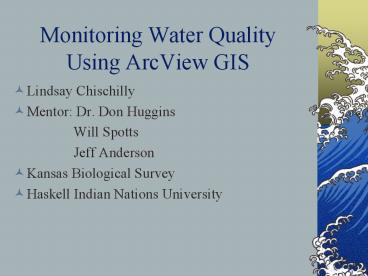Monitoring Water Quality Using ArcView GIS - PowerPoint PPT Presentation
1 / 24
Title:
Monitoring Water Quality Using ArcView GIS
Description:
Sources of NPSP include agriculture, industries, and mining. ... Compost Spreading. Crop Rotation. Rainfall Event Frequency, Intensity and Duration. Conclusions ... – PowerPoint PPT presentation
Number of Views:218
Avg rating:3.0/5.0
Title: Monitoring Water Quality Using ArcView GIS
1
Monitoring Water Quality Using ArcView GIS
- Lindsay Chischilly
- Mentor Dr. Don Huggins
- Will Spotts
- Jeff Anderson
- Kansas Biological Survey
- Haskell Indian Nations University
2
Overview
- Nonpoint Source Pollution
- Water Quality Research Methods
- Geographic Information Systems
- Results of Monitoring Program
3
Definition of Terms
- Nonpoint Source Pollution (NPSP)- the broad range
of pollution with no specific point of origin.
Sources of NPSP include agriculture, industries,
and mining. NPSP is weather dependent and not
yet subject to federal regulations.
4
Definition of Terms (continued)
- Point Source Pollution-point sources generally
enter receiving water bodies at some identifiable
site(s) and carry pollutants whose generation is
controlled by some internal process or activity,
rather than weather.
5
Clean Water Farms Project
- 33 farms in eastern Kansas were given federal
grant money to address local water quality
management issues. - 8 farms are monitored by the Kansas Biological
Survey.
6
Purpose of CWFP Monitoring Program
- Detect changes in NPSP at the field level.
- Relate changes in nutrient and herbicide
concentrations to changes in land management.
7
Participating Farms
8
(No Transcript)
9
(No Transcript)
10
Methods
- Sampling Devices
- Lysimeter
- Automatic Runoff Sampler
- Geographic Information Systems
11
Methods (continued)
- Lysimeters-uses a vacuum and then pressure to
collect groundwater at depths of one, four, and
eight feet. The eight foot tube are the most
reliable samplers.
12
Methods (continued)
- Automatic Runoff Sampler-used to collect eight
samples of surface runoff over the first three
hours of a storm.
13
GIS Overview
- Computer system capable of holding and using
data to describe places on the earths surface. - Manipulate, analyze, store, and display spatial
data. - Links data to geographic locations
14
Monitoring Water Quality Using GIS
15
Monitoring Water Quality Using GIS
16
Monitoring Water Quality Using GIS
17
Monitoring Water Quality Using GIS
18
Monitoring Water Quality Using GIS
19
Results
20
(No Transcript)
21
(No Transcript)
22
(No Transcript)
23
Sources of Variation
- Seasonal Land Management
- Tilling and Planting
- Herbicide Application
- Compost Spreading
- Crop Rotation
- Rainfall Event Frequency, Intensity and Duration
24
Conclusions
- GIS is a creative tool to help visualize and
analyze the issues affecting water quality. - There are many contributing factors in the
overall water quality in agricultural landscapes.
- Groundwater concentrations of TP are more
variable than TN over space and time. - Need more time to identify and quantify the
specific effects of land management on
agricultural water quality.

